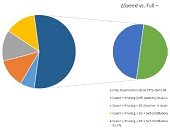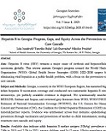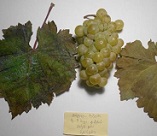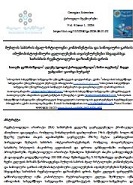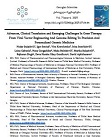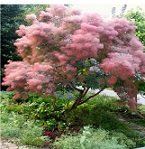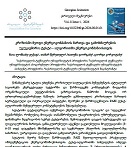Chemical Composition and Biological Activity of Species of the Genus Heracleum
Downloads
Funding data
-
Shota Rustaveli National Science Foundation
Grant numbers PHDF-22-4838
Heracleum is the widest genera of the Apiaceae family. From these genus 120 species, 25 are growing in Caucasus, while 23 are spread in Georgia, among them 5 species are endemic. According to the literature, only 1/6 of Heracleum species have been studied phytochemically. Plants of this genus contain aromatic compounds and are considered to be a very rich source of essential oils and diverse furanocoumarins. Heracleum species are well-known in folk medicine all over the world. They are used as remedies for various diseases, as food and beverages (mostly as spices). Plants from the mentioned genus possess a wide spectrum of biological activity, such as antimicrobial, anti-inflammatory, anticancer, antioxidant, antidiabetic,antiviral, etc.
Downloads
Kuchukhidze, R. Gagnidze, T. Gviniashvili, and M. Jokhadze, Endemic Flowering Plants of Georgian Flora. Tbilisi, 2018.
D. N. Purushothaman and S. Ravi, “GC–MS analysis of essential oil obtained from Heracleum candolleanum (Wight et Arn),” J. Pharm. Res., vol. 6, no. 1, pp. 155–157, Jan. 2013, doi: 10.1016/j.jopr.2012.11.032.
M. B. Bahadori, L. Dinparast, and G. Zengin, “The Genus Heracleum : A Comprehensive Review on Its Phytochemistry, Pharmacology, and Ethnobotanical Values as a Useful Herb: The genus Heracleum …,” Compr. Rev. Food Sci. Food Saf., vol. 15, no. 6, pp. 1018–1039, Nov. 2016, doi: 10.1111/1541-4337.12222.
A. J. John, V. P. Karunakaran, V. George, and M. G. Sethuraman, “Chemical Composition of Leaf and Fruit Oils of Heracleum candolleanum,” J. Essent. Oil Res., vol. 19, no. 4, pp. 358–359, Jul. 2007, doi: 10.1080/10412905.2007.9699304.
maryam rezapoor, “Optimization of Effective Parameters in Essential Oil Extraction of Heracleum persicum Desf. Ex Fischer Seed Using Response Surface Methodology,” Eco-Phytochem. J. Med. Plants, vol. 7, no. 4, pp. 49–63, 2020.
F. Mojab, A. Rustaiyan, and A. R. Jasbi, “Essential oils of Heracleum persicum Desf. ex Fischer leaves,” Daru, vol. 10, pp. 6–8, Jul. 2002.
N. shariatifar, T. Mostaghim, A. Afshar, I. Mohammadpourfard, M. Sayadi, and M. Rezaei, “Antibacterial Properties of Essential Oil of Heracleum persicum (Golpar) and Foodborne Pathogens,” Int. J. Enteric Pathog., vol. 5, no. 2, pp. 41–44, May 2017, doi: 10.15171/ijep.2017.10.
F. Saeidi, H. Azhdari-Zarmehri, B. Alimohammadi, and E. Erami, “The effect of hydroalcoholic extract of Heracleum Persicum on pentylenetetrazol _induced seizure in mice,” J. Zanjan Univ. Med. Sci. Health Serv., vol. 21, pp. 45–55, Jan. 2013.
M. Sabzi Nojadeh, M. Amani, and M. Younessi Hamzekhanlu, “Medicinal uses of rangeland plants by indigenous communities in the Qaradagh region (Case study: Ahar county, East Azerbaijan province),” J. Environ. Sci. Stud., vol. 6, no. 1, pp. 3370–3382, 2021.
M. Alam, B.-J. Seo, P. Zhao, and S.-H. Lee, “Anti-Melanogenic Activities of Heracleum moellendorffii via ERK1/2-Mediated MITF Downregulation,” Int. J. Mol. Sci., vol. 17, no. 11, p. 1844, Nov. 2016, doi: 10.3390/ijms17111844.
M. Sayyah, S. Moaied, and M. Kamalinejad, “Anticonvulsant activity of Heracleum persicum seed,” J. Ethnopharmacol., vol. 98, no. 1–2, pp. 209–211, Apr. 2005, doi: 10.1016/j.jep.2004.12.026.
V. Hajhashemi, S. E. Sajjadi, and M. Heshmati, “Anti-inflammatory and analgesic properties of Heracleum persicum essential oil and hydroalcoholic extract in animal models,” J. Ethnopharmacol., vol. 124, no. 3, pp. 475–480, Jul. 2009, doi: 10.1016/j.jep.2009.05.012.
A. Naeini, H. Shokri, and A. R. Khosravi, “Immunostimulatory Effects of Aqueous Extract of Heracleum persicum Desf. on Mouse Peritoneal Macrophages,” Jundishapur J. Microbiol., Jul. 2013, doi: 10.5812/jjm.5373.
T. Radjabian, A. Salimi, N. Rahmani, A. Shockravi, and V. Mozaffarian, “Essential Oil Composition of Some Wild Populations of Heracleum persicum Desf. Ex Fischer Growing in Iran,” J. Essent. Oil Bear. Plants, vol. 16, no. 6, pp. 841–849, Nov. 2013, doi: 10.1080/0972060X.2013.862078.
B. Sadeghi Nejad, M. Rajabi, A. Zarei Mamoudabadi, and M. Zarrin, “In Vitro Anti-Candida Activity of the Hydroalcoholic Extracts of Heracleum persicum Fruit Against Phatogenic Candida Species,” Jundishapur J. Microbiol., vol. 7, no. 1, Jan. 2014, doi: 10.5812/jjm.8703.
T. Radjabian, A. Salimi, and N. Rahmani, “Essential-Oil Composition of the Fruits of Six Heracleum L. Species from Iran: Chemotaxonomic Significance,” Chem. Biodivers., vol. 11, no. 12, pp. 1945–1953, Dec. 2014, doi: 10.1002/cbdv.201400085.
Y. Dadjo et al., “Effects of Supplementation with Heracleum persicum Fruit Extract on Serum Lipids in Patients Undergoing Coronary Angiography: A Pilot Trial: EFFECT OF HERACLEUM PERSICUM ON SERUM LIPIDS,” Phytother. Res., vol. 29, no. 1, pp. 141–143, Jan. 2015, doi: 10.1002/ptr.5214.
Y. Gao, Y. Liu, Z. Wang, and H. Zhang, “Chemical constituents of Heracleum dissectum and their cytotoxic activity,” Phytochem. Lett., vol. 10, pp. 276–280, Dec. 2014, doi: 10.1016/j.phytol.2014.10.008.
S. Rastogi, M. M. Pandey, and A. K. S. Rawat, “Determination of Heraclenin and Heraclenol in Heracleum candicans D.C. by TLC,” Chromatographia, vol. 66, no. 7–8, pp. 631–634, Sep. 2007, doi: 10.1365/s10337-007-0357-9.
K. G. Tkachenko, “Essential oils from leaves of several Heracleum species growing in Leningrad Oblast,” Chem. Nat. Compd., vol. 46, no. 2, pp. 319–321, May 2010, doi: 10.1007/s10600-010-9603-8.
A. Inoue, M. Shibano, M. Taniguchi, K. Baba, and N.-H. Wang, “Four novel furanocoumarin glucosides, candinosides A, B, C and D, from Heracleum candicans Wall,” J. Nat. Med., vol. 65, no. 1, pp. 116–121, Jan. 2011, doi: 10.1007/s11418-010-0470-1.
A. K. S. Rawat, A. P. Singh, D. P. Singh, M. M. Pandey, R. Govindarajan, and S. Srivastava, “Separation and Identification of Furocoumarin in Fruits of Heracleum candicans DC. by HPTLC,” J. Chem., vol. 2013, pp. 1–4, 2013, doi: 10.1155/2013/915762.
R. S. Chauhan, M. C. Nautiyal, A. Tava, and R. Cecotti, “Essential oil composition from leaves of Heracleum candicans Wall.: a sustainable method for extraction,” J. Essent. Oil Res., vol. 26, no. 2, pp. 130–132, Mar. 2014, doi: 10.1080/10412905.2013.868330.
S. Dash, L. K. Nath, and S. Bhise, “Antioxidant and antimicrobial activities of Heracleum nepalense D Don root,” Trop. J. Pharm. Res., vol. 4, no. 1, pp. 341–347, Jul. 2007, doi: 10.4314/tjpr.v4i1.14618.
S. K. Bose, S. Dewanjee, R. Sahu, and S. P. Dey, “Effect of bergapten from Heracleum nepalense root on production of proinflammatory cytokines,” Nat. Prod. Res., vol. 25, no. 15, pp. 1444–1449, Sep. 2011, doi: 10.1080/14786410902800665.
E. G. Shakhmatov, P. V. Toukach, S. P. Kuznetsov, and E. N. Makarova, “Structural characteristics of water-soluble polysaccharides from Heracleum sosnowskyi Manden,” Carbohydr. Polym., vol. 102, pp. 521–528, Feb. 2014, doi: 10.1016/j.carbpol.2013.12.001.
T. Ozek, B. Demirci, and K. H. C. Baser, “[No title found],” Chem. Nat. Compd., vol. 38, no. 1, pp. 48–50, 2002, doi: 10.1023/A:1015777614626.
A. Ergene, P. Güler, S. Tan, S. Mirici, E. Hamzaoğlu, and A. Duran, “Antibacterial and antifungal activity of Heracleum sphondylium subsp. artvinense,” Afr. J. Biotechnol., vol. 5, pp. 1087–1089, May 2006.
F. Senejoux et al., “Vasorelaxant effects and mechanisms of action of Heracleum sphondylium L. (Apiaceae) in rat thoracic aorta,” J. Ethnopharmacol., vol. 147, no. 2, pp. 536–539, May 2013, doi: 10.1016/j.jep.2013.03.030.
F. Maggi et al., “Composition and biological activities of hogweed [ Heracleum sphondylium L. subsp. ternatum (Velen.) Brummitt] essential oil and its main components octyl acetate and octyl butyrate,” Nat. Prod. Res., vol. 28, no. 17, pp. 1354–1363, Sep. 2014, doi: 10.1080/14786419.2014.904311.
A. Bogucka-Kocka and T. Krzaczek, “The furanocoumarins in the roots of Heracleum sibiricum L,” Acta Pol. Pharm., vol. 60, no. 5, pp. 391–393, 2003.
W. Li, L. Chen, C. Wu, and J. Xin, “Analysis of the Essential Oil from Seed of Heracleum moellendorffii Hance Cultivated in Northeast China,” Asian J. Chem., vol. 25, no. 8, pp. 4701–4702, 2013, doi: 10.14233/ajchem.2013.13945.
T. O׳Neill, J. A. Johnson, D. Webster, and C. A. Gray, “The Canadian medicinal plant Heracleum maximum contains antimycobacterial diynes and furanocoumarins,” J. Ethnopharmacol., vol. 147, no. 1, pp. 232–237, May 2013, doi: 10.1016/j.jep.2013.03.009.
D. Di̇Ncel, “Anticholinesterase furocoumarins from Heracleum platytaenium, an endemic species to Idea mountains,” Turk. J. Chem., 2013, doi: 10.3906/kim-1303-55.
A. G. Karimi and M. Ito, “Sedative effect of vapor inhalation of essential oil from Heracleum afghanicum Kitamura seeds,” J. Essent. Oil Res., vol. 24, no. 6, pp. 571–577, Dec. 2012, doi: 10.1080/10412905.2012.728085.
T. Kuljanabhagavad, N. Sriubolmas, and N. Ruangrungsi, “Chemical composition, antibacterial and antifungal activities of essential oil from Heracleum Siamicum Craib,” Pharm. Chem. J., vol. 45, no. 3, p. 178, Jun. 2011, doi: 10.1007/s11094-011-0587-x.
S. Karuppusamy and G. Muthuraja, “Chemical Composition and Antioxidant Activity of Heracleum sprengelianum (Wight and Arnott) Essential Oils Growing Wild in Peninsular India,” Iran. J. Pharm. Res. IJPR, vol. 10, no. 4, pp. 769–775, 2011.
W. Xiao, S. Li, X. Niu, Y. Zhao, and H. Sun, “Rapulasides A and B: two novel intermolecular rearranged biiridoid glucosides from the roots of Heracleum rapula,” Tetrahedron Lett., vol. 46, no. 34, pp. 5743–5746, Aug. 2005, doi: 10.1016/j.tetlet.2005.06.094.
C. Zhang, Y. Liu, Y. Q. Xiao, and L. Li, “A new trimeric furanocoumarin from Heracleum rapula,” Chin. Chem. Lett., vol. 20, no. 9, pp. 1088–1090, Sep. 2009, doi: 10.1016/j.cclet.2009.05.005.
S. K. Bose, S. Dewanjee, and S. C. Mandal, “Antibacterial activity of methanol extract of roots of Heracleum nepalense D Don. on bacteria causing diarrhoea,” Orient. Pharm. Exp. Med., vol. 7, no. 3, pp. 286–289, Sep. 2007, doi: 10.3742/OPEM.2007.7.3.286.
M. Taniguchi, O. Yokota, M. Shibano, N.-H. Wang, and K. Baba, “Four Coumarins from Heracleum yunngningense,” Chem. Pharm. Bull. (Tokyo), vol. 53, no. 6, pp. 701–704, 2005, doi: 10.1248/cpb.53.701.
L.-L. Yang et al., “Effects of sphondin, isolated from Heracleum laciniatum, on IL–1β-induced cyclooxygenase-2 expression in human pulmonary epithelial cells,” Life Sci., vol. 72, no. 2, pp. 199–213, Nov. 2002, doi: 10.1016/S0024-3205(02)02173-2.
K. Glowniak, T. Mroczek, A. Zabza, and T. Cierpicki, “Isolation And Structure Elucidation Of 5,7–disubstituted Simple Coumarins In The Fruits Of Heracleum Mantegazzianum,” Pharm. Biol., vol. 38, no. 4, pp. 308–312, Oct. 2000, doi: 10.1076/1388-0209(200009)3841-AFT308.
F. Mahmoodi, H. Valizadeh, Z. Hosseinzade, and M. B. Bahadori, “Furocoumarins from Heracleum rawianum in Iran,” Iran. Chem. Commun., vol. 3, pp. 1–6, Jan. 2015.
D. Lingaraju and M. S. Sudarshana, “Antimicrobial activity and phytochemical screening of roots of Heracleum rigenswall Ex DC,” Int. J. Pharma Bio Sci., vol. 67, pp. 288–294, Apr. 2014.
M. Ghabril, N. Chalasani, and E. Björnsson, “Drug-induced liver injury: a clinical update:,” Curr. Opin. Gastroenterol., vol. 26, no. 3, pp. 222–226, May 2010, doi: 10.1097/MOG.0b013e3283383c7c.
N. A. Osna, T. M. Donohue, and K. K. Kharbanda, “Alcoholic Liver Disease: Pathogenesis and Current Management,” Alcohol Res. Curr. Rev., vol. 38, no. 2, pp. 147–161, 2017.
X. Gu and J. E. Manautou, “Molecular mechanisms underlying chemical liver injury,” Expert Rev. Mol. Med., vol. 14, p. e4, Feb. 2012, doi: 10.1017/S1462399411002110.
T. Kietzmann and A. Görlach, “Reactive oxygen species in the control of hypoxia-inducible factor-mediated gene expression,” Semin. Cell Dev. Biol., vol. 16, no. 4–5, pp. 474–486, Aug. 2005, doi: 10.1016/j.semcdb.2005.03.010.
M. Ayaz et al., “Phenolic contents, antioxidant and anticholinesterase potentials of crude extract, subsequent fractions and crude saponins from Polygonum hydropiper L,” BMC Complement. Altern. Med., vol. 14, no. 1, p. 145, Dec. 2014, doi: 10.1186/1472-6882-14-145.
H. Cichoż-Lach and A. Michalak, “Oxidative stress as a crucial factor in liver diseases,” World J. Gastroenterol., vol. 20, no. 25, pp. 8082–8091, Jul. 2014, doi: 10.3748/wjg.v20.i25.8082.
L. Zhou and J. Zeng, “Research advances on chemical constituents and pharmacological effects of angelica pubescens,” Modern Chin Med, vol. 21, no. 12, pp. 1739–1748, 2019.
J. Li et al., “Hepatoprotective Effects of Heracleum candicans Against Carbon Tetrachloride-Induced Acute Liver Injury in Rats,” Dose-Response, vol. 19, no. 3, p. 155932582110295, Jul. 2021, doi: 10.1177/15593258211029510.
O. Jakubowicz, C. Żaba, G. Nowak, S. Jarmuda, R. Żaba, and J. Marcinkowski, “Heracleum Sosnowskyi Manden,” Ann. Agric. Environ. Med., vol. 19, no. 2, pp. 327–328, Jun. 2012.
“Plants of the World Online. Facilitated by the Royal Botanic Gardens, Kew.” Jan. 26, 2023. [Online]. Available: http://www.plantsoftheworldonline.org
Iliana Ilieva, “Names of botanical genera inspired by mythology,” GSC Biol. Pharm. Sci., vol. 14, no. 3, pp. 008–018, Mar. 2021, doi: 10.30574/gscbps.2021.14.3.0050.
Z. Dajdok and P. Pawlaczyk, Eds., Inwazyjne gatunki roślin ekosystemów mokradłowych Polski. Świebodzin: Wydawnictwo Klubu Przyrodników, 2009.
R. Wojtkowiak, H. Kawalec, and A. P. Dubowski, “Heracleum Sosnowskyi Mandel L.,” J. Res. Appl. Agric. Eng. Pol., vol. 53, no. 4, pp. 137–142, 2009.
GBIF.Org User, “Occurrence Download.” The Global Biodiversity Information Facility, 2023. doi: 10.15468/DL.KNDH4E.
M. Mishyna, N. Laman, V. Prokhorov, and Y. Fujii, “Angelicin as the principal allelochemical in Heracleum sosnowskyi fruit,” Nat. Prod. Commun., vol. 10, no. 5, pp. 767–770, May 2015.
A. Jakubska-Busse, M. Śliwiński, and M. Kobyłka, “Identification of bioactive components of essential oils in Heracleum sosnowskyi and Heracleum mantegazzianum (Apiaceae),” Arch. Biol. Sci., vol. 65, no. 3, pp. 877–883, 2013, doi: 10.2298/ABS1303877J.
“Plants of the Genus Heracleum as a Source of Coumarin and Furanocoumarin,” J. Chem. Rev., vol. 1, no. 2, pp. 78–98, Apr. 2019, doi: 10.33945/SAMI/JCR.2019.1.7898.
C. Zhang et al., “A new coumarin isolated from the roots of Heracleum dissectum Ledeb,” Nat. Prod. Res., pp. 1–6, Aug. 2020, doi: 10.1080/14786419.2020.1810033.
G. Ozek et al., “Furanocoumarin Content, Antioxidant Activity, and Inhibitory Potential of Heracleum verticillatum, Heracleum sibiricum, Heracleum angustisectum , and Heracleum ternatum Extracts against Enzymes Involved in Alzheimer’s Disease and Type II Diabetes,” Chem. Biodivers., vol. 16, no. 4, Apr. 2019, doi: 10.1002/cbdv.201800672.
J. Trott, W. Gerber, S. Hammes, and H. Ockenfels, “The effectiveness of PUVA treatment in severe psoriasis is significantly increased by additional UV 308-nm excimer laser sessions,” Eur J Dermatol, vol. 18, no. 1, pp. 55–60, Feb. 2008, doi: 10.1684/ejd.2008.0311.
A. Bhatnagar, A. Kanwar, D. Parsad, and D. De, “Psoralen and ultraviolet A and narrow-band ultraviolet B in inducing stability in vitiligo, assessed by vitiligo disease activity score: an open prospective comparative study,” J. Eur. Acad. Dermatol. Venereol., vol. 21, no. 10, pp. 1381–1385, Nov. 2007, doi: 10.1111/j.1468-3083.2007.02283.x.
J. Wang, X. Zhang, N. Gao, and Y. Wang, “Polyphenolic content and antioxidant capacity of whole plants and different parts of Heraclenm dissectum,” Food Sci., vol. 40, pp. 54–59, 2019.
K. Flanagan, “Botanical Briefs: Phytophotodermatitis Caused by Giant Hogweed (Heracleum mantegazzianum),” Cutis, vol. 108, no. 5, Nov. 2021, doi: 10.12788/cutis.0389.
E. Pira, C. Romano, F. Sulotto, I. Pavan, and E. Monaco, “Heracleum mantegazzianum growth phases and furocoumarin content,” Contact Dermatitis, vol. 21, no. 5, pp. 300–303, Nov. 1989, doi: 10.1111/j.1600-0536.1989.tb04747.x.
J. W. Downs, K. L. Cumpston, and M. J. Feldman, “Giant Hogweed phytophotodermatitis,” Clin. Toxicol., vol. 57, no. 9, pp. 822–823, Sep. 2019, doi: 10.1080/15563650.2018.1559327.
K. Pfurtscheller and M. Trop, “Phototoxic Plant Burns: Report of a Case and Review of Topical Wound Treatment in Children,” Pediatr. Dermatol., vol. 31, no. 6, pp. e156–e159, Nov. 2014, doi: 10.1111/pde.12396.
J. C. Y. Chan, P. J. Sullivan, M. J. O’Sullivan, and P. A. Eadie, “Full thickness burn caused by exposure to giant hogweed: Delayed presentation, histological features and surgical management,” J. Plast. Reconstr. Aesthet. Surg., vol. 64, no. 1, pp. 128–130, Jan. 2011, doi: 10.1016/j.bjps.2010.03.030.
N. Z. Mamadalieva, N. S. Abdullaeva, T. Rosenau, M. Fakhrutdinova, S. S. Azimova, and S. Böhmdorfer, “Composition of essential oils from four Apiaceae and Asteraceae species growing in Uzbekistan,” Nat. Prod. Res., vol. 32, no. 9, pp. 1118–1122, May 2018, doi: 10.1080/14786419.2017.1375928.
M. Ghavam, “Heracleum persicum Desf. ex Fisch., C.A.Mey. & Avé-Lall. fruit essential oil: content, antimicrobial activity and cytotoxicity against ovarian cancer cell line,” BMC Complement. Med. Ther., vol. 23, no. 1, p. 87, Mar. 2023, doi: 10.1186/s12906-023-03892-2.
L. J. Ušjak, M. M. Drobac, M. S. Niketić, and S. D. Petrović, “Chemosystematic Significance of Essential Oil Constituents and Furanocoumarins of Underground Parts and Fruits of Nine Heracleum L. Taxa from Southeastern Europe,” Chem. Biodivers., p. cbdv.201800412, Dec. 2018, doi: 10.1002/cbdv.201800412.
P. Gürbüz, “Flavonoid Glycosides from Heracleum pastinaca Fenzl,” Turk. J. Pharm. Sci., vol. 16, no. 2, pp. 191–195, Jun. 2019, doi: 10.4274/tjps.galenos.2018.53215.
C. J. Hawkey, “Non-steroidal anti-inflammatory drugs: overall risks and management. Complementary roles for COX-2 inhibitors and proton pump inhibitors,” Gut, vol. 52, no. 4, pp. 600–608, Apr. 2003, doi: 10.1136/gut.52.4.600.
H. P. Syama, T. Sithara, S. Lekshmy Krishnan, and P. Jayamurthy, “Syzygium cumini seed attenuates LPS induced inflammatory response in murine macrophage cell line RAW264.7 through NF-κB translocation,” J. Funct. Foods, vol. 44, pp. 218–226, May 2018, doi: 10.1016/j.jff.2018.01.027.
S. O. Abarikwu, “Kolaviron, a natural flavonoid from the seeds of Garcinia kola, reduces LPS-induced inflammation in macrophages by combined inhibition of IL-6 secretion, and inflammatory transcription factors, ERK1/2, NF-κB, p38, Akt, p-c-JUN and JNK,” Biochim. Biophys. Acta BBA - Gen. Subj., vol. 1840, no. 7, pp. 2373–2381, Jul. 2014, doi: 10.1016/j.bbagen.2014.03.006.
P.-H. Nguyen, B. T. Zhao, J. H. Lee, Y. H. Kim, B. S. Min, and M. H. Woo, “Isolation of benzoic and cinnamic acid derivatives from the grains of Sorghum bicolor and their inhibition of lipopolysaccharide-induced nitric oxide production in RAW 264.7 cells,” Food Chem., vol. 168, pp. 512–519, Feb. 2015, doi: 10.1016/j.foodchem.2014.06.119.
Z.-S. Wen et al., “Composition and anti-inflammatory effect of polysaccharides from Sargassum horneri in RAW264.7 macrophages,” Int. J. Biol. Macromol., vol. 88, pp. 403–413, Jul. 2016, doi: 10.1016/j.ijbiomac.2016.02.025.
H. N. Kim et al., “Heracleum moellendorffii roots inhibit the production of pro-inflammatory mediators through the inhibition of NF-κB and MAPK signaling, and activation of ROS/Nrf2/HO-1 signaling in LPS-stimulated RAW264.7 cells,” BMC Complement. Altern. Med., vol. 19, no. 1, p. 310, Dec. 2019, doi: 10.1186/s12906-019-2735-x.
Y. Nakano, H. Matsunaga, T. Saita, M. Mori, M. Katano, and H. Okabe, “Antiproliferative Constituents in Umbelliferae Plants II. Screening for Polyacetylenes in Some Umbelliferae Plants, and Isolation of Panaxynol and Falcarindiol from the Root of Heracleum moellendorffii.,” Biol. Pharm. Bull., vol. 21, no. 3, pp. 257–261, 1998, doi: 10.1248/bpb.21.257.
A. L. Stefanson and M. Bakovic, “Falcarinol Is a Potent Inducer of Heme Oxygenase-1 and Was More Effective than Sulforaphane in Attenuating Intestinal Inflammation at Diet-Achievable Doses,” Oxid. Med. Cell. Longev., vol. 2018, pp. 1–14, Oct. 2018, doi: 10.1155/2018/3153527.
F. Ashkar et al., “The Role of medicinal herbs in treatment of insulin resistance in patients with Polycystic Ovary Syndrome: A literature review,” Biomol. Concepts, vol. 11, no. 1, pp. 57–75, Mar. 2020, doi: 10.1515/bmc-2020-0005.
Homa Mohseni Kouchesfahani, Mohammad Nabyooni, and Hamed Adham, “Investigating the Therapeutic Effect of Bee Venom on Polycystic Ovarian Syndrome in Rats,” Pajoohandeh, vol. 15, no. 1, pp. 1–6, Apr. 2010.
T. L. Marx and A. E. Mehta, “Polycystic ovary syndrome: pathogenesis and treatment over the short and long term.,” Cleve. Clin. J. Med., vol. 70, no. 1, pp. 31–33, Jan. 2003, doi: 10.3949/ccjm.70.1.31.
I. Haj-Husein, S. Tukan, and F. Alkazaleh, “The effect of marjoram ( Origanum majorana ) tea on the hormonal profile of women with polycystic ovary syndrome: a randomised controlled pilot study,” J. Hum. Nutr. Diet., vol. 29, no. 1, pp. 105–111, Feb. 2016, doi: 10.1111/jhn.12290.
A. Farzaneh, M. Azarnia, G. Mirabolghasemi, and K. Parya, “Effect of Fruit Heracleum Persicum Extract on Changes in Serum Levels of Sex Hormones in Rats with Polcystic Ovary Syndrome (PCOS),” Armaghane-Danesh Yasuj Univ. Orig. Artic. Med. Sci. J. YUMSJ, vol. 20, pp. 31–42, Apr. 2015.
E. E. Alkan and I. Celik, “The therapeutics effects and toxic risk of Heracleum persicum Desf. extract on streptozotocin-induced diabetic rats,” Toxicol. Rep., vol. 5, pp. 919–926, 2018, doi: 10.1016/j.toxrep.2018.08.004.
R. Afrisham, M. Aberomand, M. A. Ghaffari, A. Siahpoosh, and M. Jamalan, “Inhibitory Effect of Heracleum persicum and Ziziphus jujuba on Activity of Alpha-Amylase,” J. Bot., vol. 2015, p. 824683, Oct. 2015, doi: 10.1155/2015/824683.
H. Dehghan, Y. Sarrafi, and P. Salehi, “Antioxidant and antidiabetic activities of 11 herbal plants from Hyrcania region, Iran,” J. Food Drug Anal., vol. 24, no. 1, pp. 179–188, Jan. 2016, doi: 10.1016/j.jfda.2015.06.010.
I. Orhan, F. Tosun, and B. Şener, “Coumarin, Anthroquinone and Stilbene Derivatives with Anticholinesterase Activity,” Z. Für Naturforschung C, vol. 63, no. 5–6, pp. 366–370, Jun. 2008, doi: 10.1515/znc-2008-5-610.
M. Walasek, A. Grzegorczyk, A. Malm, and K. Skalicka-Woźniak, “Bioactivity-guided isolation of antimicrobial coumarins from Heracleum mantegazzianum Sommier & Levier (Apiaceae) fruits by high-performance counter-current chromatography,” Food Chem., vol. 186, pp. 133–138, Nov. 2015, doi: 10.1016/j.foodchem.2015.02.011.
A. Kousha and E. Ringø, “Antibacterial Effect of Aquatic Extract of Heracleum Spp. Hogweed Plants from Europe on Thirteen Different Bacteria,” Pharm. Chem. J., vol. 48, no. 10, pp. 675–678, Jan. 2015, doi: 10.1007/s11094-015-1169-0.
A. Akcin, F. Seyis, T. A. Akcin, Y. T. Cayci, and A. Y. Coban, “Chemical Composition and Antimicrobial Activity of the Essential Oil of Endemic Heracleum platytaenium Boiss. from Turkey,” J. Essent. Oil Bear. Plants, vol. 16, no. 2, pp. 166–171, Apr. 2013, doi: 10.1080/0972060X.2013.793966.
A. Kousha and M. Bayat, “Bactericidal and Fungicidal Activity of Methanolic Extracts of Heracleum persicum Desf. ex Fischer against Some Aquatic and Terrestrial Animal Pathogens,” Int. J. Pharmacol., vol. 8, no. 7, pp. 652–656, Sep. 2012, doi: 10.3923/ijp.2012.652.656.
M. Arsene et al., “In vitro antimicrobial activity, antibioresistance reversal properties, and toxicity screen of ethanolic extracts of Heracleum mantegazzianum Sommier & Levier (giant hogweed), Centaurea jacea L. (brown knapweed) and Chenopodium album L. (Pigweed): three invasive plants,” Open Vet. J., vol. 12, no. 4, p. 584, 2022, doi: 10.5455/OVJ.2022.v12.i4.22.
O. Firuzi, M. Asadollahi, M. Gholami, and K. Javidnia, “Composition and biological activities of essential oils from four Heracleum species,” Food Chem., vol. 122, no. 1, pp. 117–122, Sep. 2010, doi: 10.1016/j.foodchem.2010.02.026.
M. Ocal et al., “Comparative Content, Biological and Anticancer Activities of Heracleum humile Extracts Obtained by Ultrasound‐Assisted Extraction Method,” Chem. Biodivers., vol. 19, no. 7, Jul. 2022, doi: 10.1002/cbdv.202101040.
M. Eskandani, J. Abdolalizadeh, H. Hamishehkar, H. Nazemiyeh, and J. Barar, “Galbanic acid inhibits HIF-1α expression via EGFR/HIF-1α pathway in cancer cells,” Fitoterapia, vol. 101, pp. 1–11, Mar. 2015, doi: 10.1016/j.fitote.2014.12.003.
V. Kafil, M. Eskandani, Y. Omidi, H. Nazemiyeh, and J. Barar, “Abietane diterpenoid of Salvia sahendica Boiss and Buhse potently inhibits MCF-7 breast carcinoma cells by suppression of the PI3K/AKT pathway,” RSC Adv., vol. 5, no. 23, pp. 18041–18050, 2015, doi: 10.1039/C4RA14905J.
M. M. Farimani et al., “New ursane triterpenoids from Salvia urmiensis Bunge: Absolute configuration and anti-proliferative activity,” Fitoterapia, vol. 106, pp. 1–6, Oct. 2015, doi: 10.1016/j.fitote.2015.07.017.
M. K. Hpoo et al., “Potential of Octanol and Octanal from Heracleum sosnowskyi Fruits for the Control of Fusarium oxysporum f. sp. lycopersici,” Sustainability, vol. 12, no. 22, p. 9334, Nov. 2020, doi: 10.3390/su12229334.
Copyright (c) 2023 GEORGIAN SCIENTISTS

This work is licensed under a Creative Commons Attribution-NonCommercial-NoDerivatives 4.0 International License.





















